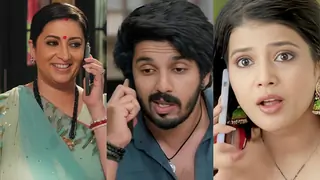https://www.sacred-texts.com/hin/vp/vp044.htm
. Then, seated on a full-blown lotus, and holding a water-lily in her hand, the goddess Śrí, radiant with beauty, rose from the waves. The great sages, enraptured, hymned her with the song dedicated to her praise 7. Viśwavasu and other heavenly quiristers sang, and Ghritáchí and other celestial nymphs danced before her. Gangá and other holy streams attended for her ablutions; and the elephants of the skies, taking up their pure waters in vases of gold, poured them over the goddess, the queen of the universal world. The sea of milk in person presented her with a wreath of never-fading flowers; and the artist of the gods (Viswakermá) decorated her person with heavenly ornaments. Thus bathed, attired, and adorned, the goddess, in the view of the celestials, cast herself upon the breast of Hari; and there reclining, turned her eyes upon the deities, who were inspired with rapture by her gaze. Not so the Daityas, who, with Viprachitti at their head, were filled with indignation, as Vishńu turned away from them, and they were abandoned by the goddess of prosperity (Lakshmí.)
The powerful and indignant Daityas then forcibly seized the Amrita-cup, that was in the hand of Dhanwantari: but Vishńu, assuming a female form, fascinated and deluded them; and recovering the Amrita
p. 77
from them, delivered it to the gods. Śakra and the other deities quaffed the ambrosia. The incensed demons, grasping their weapons, fell upon them; but the gods, into whom the ambrosial draught had infused new vigour, defeated and put their host to flight, and they fled through the regions of space, and plunged into the subterraneous realms of Pátála. The gods thereat greatly rejoiced, did homage to the holder of the discus and mace, and resumed their reign in heaven. The sun shone with renovated splendour, and again discharged his appointed task; and the celestial luminaries again circled, oh best of Munis, in their respective orbits. Fire once more blazed aloft, beautiful in splendour; and the minds of all beings were animated by devotion. The three worlds again were rendered happy by prosperity; and Indra, the chief of the gods, was restored to power 8. Seated upon his throne, and once more in
p. 78
heaven, exercising sovereignty over the gods, Śakra thus eulogized the goddess who bears a lotus in her hand:--
"I bow down to Śrí, the mother of all beings, seated on her lotus throne, with eyes like full-blown lotuses, reclining on the breast of Vishńu. ...
Paráśara proceeded.--Thus, Maitreya, in former times the goddess Śrí conferred these boons upon the king of the gods, being pleased by his adorations; but her first birth was as the daughter of Bhrigu by Khyáti: it was at a subsequent period that she was produced from the sea, at the churning of the ocean by the demons and the gods, to obtain ambrosia
https://www.sacred-texts.com/hin/vp/vp045.htm
PARÁŚARA.--Lakshmí, the bride of Vishńu, was the daughter of Bhrigu by Khyáti. They had also two sons, Dhátri and Vidhátri, who married the two daughters of the illustrious Meru, Áyati and Niryati; and had by them each a son, named Práńa and Mrikańd́a. The son of the latter was Márkańd́eya, from whom Vedaśiras was born 1. The son of Práńa was named Dyutimat, and his son was Rájavat; after whom, the race of Bhrigu became infinitely multiplied.
Sambhúti, the wife of Maríchi, gave birth to Paurnamása, whose sons were Virajas and Sarvaga. I shall hereafter notice his other descendants, when I give a more particular account of the race of Maríchi 2.
The wife of Angiras, Smriti, bore daughters named Siniválí, Kuhu,
p. 83
[paragraph continues]Ráká, and Anumati (phases of the moon 3). Anasúyá, the wife of Atri, was the mother of three sinless sons, Soma (the moon), Durvásas, and the ascetic Dattátreya 4. Pulastya had, by Príti, a son called in a former birth, or in the Swáyambhuva Manwantara, Dattoli, who is now known as the sage Agastya 5. Kshamá, the wife of the patriarch Pulaha, was the mother of three sons, Karmasa, Arvarívat, and Sahishńu 6. The wife of Kratu, Sannati, brought forth the sixty thousand Bálakhilyas, pigmy sages, no bigger than a joint of the thumb, chaste, pious, resplendent as the rays of the sun 7. Vaśisht́ha had seven sons by his wife Urjjá, Rajas, Gátra, Úrddhabáhu, Savana, Anagha, Sutapas, and Śukra, the seven pure sages 8. The Agni named Abhimání, who is the eldest born of
p. 84
[paragraph continues]Brahmá, had, by Swáhá, three sons of surpassing brilliancy, Pávaka, Pavamána, and Śuchi, who drinks up water: they had forty-five sons, who, with the original son of Brahmá and his three descendants, constitute the forty-nine fires 9. The progenitors (Pitris), who, as I have mentioned, were created by Brahmá, were the Agnishwáttas and Varhishads; the former being devoid of, and the latter possessed of, fires 10. By them, Swadhá had two daughters, Mená and Dháraní, who were both acquainted with theological truth, and both addicted to religious meditation; both accomplished in perfect wisdom, and adorned with all estimable qualities 11. Thus has been explained the progeny of the
p. 85
daughters of Daksha 12. He who with faith recapitulates the account, shall never want offspring.

































